Related Research Articles

Yellowjacket or yellow jacket is the common name in North America for predatory social wasps of the genera Vespula and Dolichovespula. Members of these genera are known simply as "wasps" in other English-speaking countries. Most of these are black and yellow like the eastern yellowjacket Vespula maculifrons and the aerial yellowjacket Dolichovespula arenaria; some are black and white like the bald-faced hornet, Dolichovespula maculata. Others may have the abdomen background color red instead of black. They can be identified by their distinctive markings, their occurrence only in colonies, and a characteristic, rapid, side-to-side flight pattern prior to landing. All females are capable of stinging. Yellowjackets are important predators of pest insects.

The superfamily Ichneumonoidea contains one extinct and three extant families, including the two largest families within Hymenoptera: Ichneumonidae and Braconidae. The group is thought to contain as many as 100,000 species, many of which have not yet been described. Like other parasitoid wasps, they were long placed in the "Parasitica", variously considered as an infraorder or an unranked clade, now known to be paraphyletic.

The large blue is a species of butterfly in the family Lycaenidae. The species was first defined in 1758 and first recorded in Britain in 1795. In 1979 the species became extinct in Britain but has been successfully reintroduced with new conservation methods. Currently large blue is classified as "near threatened" on the IUCN Red List of Threatened Species. Today P. arion can be found in Europe, the Caucasus, Armenia, western Siberia, Altai, north-western Kazakhstan and Sichuan.

Brood parasites are organisms that rely on others to raise their young. The strategy appears among birds, insects and fish. The brood parasite manipulates a host, either of the same or of another species, to raise its young as if it were its own, using brood mimicry, for example by having eggs that resemble the host's.

Myrmica rubra, also known as the European fire ant or common red ant, is a species of ant of the genus Myrmica, found all over Europe and is now invasive in some parts of North America and Asia. It is mainly red in colour, with slightly darker pigmentation on the head. These ants live under stones and fallen trees, and in soil. They are aggressive, often attacking rather than running away, and are equipped with a sting, though they lack the ability to spray formic acid like the genus Formica.

The black garden ant, also known as the common black ant, is a formicine ant, the type species of the subgenus Lasius, which is found across Europe and in some parts of North America, South America, Asia and Australasia. The European species was split into two species; L. niger, which are found in open areas; and L. platythorax, which is found in forest habitats. It is monogynous, meaning colonies contain a single queen.

Lycaenidae is the second-largest family of butterflies, with over 6,000 species worldwide, whose members are also called gossamer-winged butterflies. They constitute about 30% of the known butterfly species.

Manduca quinquemaculata, the five-spotted hawkmoth, is a brown and gray hawk moth of the family Sphingidae. The caterpillar, often referred to as the tomato hornworm, can be a major pest in gardens; they get their name from a dark projection on their posterior end and their use of tomatoes as host plants. Tomato hornworms are closely related to the tobacco hornworm Manduca sexta. This confusion arises because caterpillars of both species have similar morphologies and feed on the foliage of various plants from the family Solanaceae, so either species can be found on tobacco or tomato leaves. Because of this, the plant on which the caterpillar is found does not indicate its species.
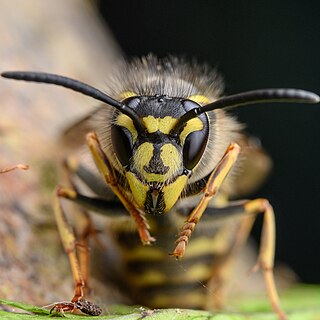
Vespula vulgaris, known as the common wasp, is found in regions that include the United Kingdom, Germany, India, China, New Zealand and Australia. It is sometimes known as the European wasp, but the same name is used for the species Vespula germanica or German wasp. Another name for Vespula vulgaris is the common yellow-jacket. In 2010, the ostensible Vespula vulgaris wasps in North America were found to be a different species, Vespula alascensis.

Phengaris alcon, the Alcon blue or Alcon large blue, is a butterfly of the family Lycaenidae and is found in Europe and across the Palearctic to Siberia and Mongolia.

The Eucharitidae are a family of parasitic wasps. Eucharitid wasps are members of the superfamily Chalcidoidea and consist of three subfamilies: Oraseminae, Eucharitinae, and Gollumiellinae. Most of the 55 genera and 417 species of Eucharitidae are members of the subfamilies Oraseminae and Eucharitinae, and are found in tropical regions of the world.
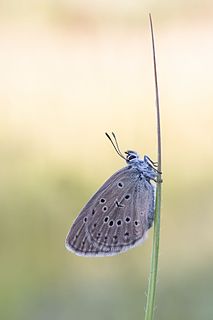
Phengaris rebeli, common name mountain Alcon blue, is a species of butterfly in the family Lycaenidae. It was first found and described in Styria, Austria, on Mount Hochschwab around 1700. Although it was initially classified as a subspecies of P. alcon, a European researcher, Lucien A. Berger, designated it as a separate species in 1946. Genetic similarities between P. rebeli and P. alcon have led many researchers to argue that the two are the same species and differences are due to intraspecific variation.

Jalmenus evagoras, the imperial hairstreak, imperial blue, or common imperial blue, is a small, metallic blue butterfly of the family Lycaenidae. It is commonly found in eastern coastal regions of Australia. This species is notable for its unique mutualism with ants of the genus Iridomyrmex. The ants provide protection for juveniles and cues for adult mating behavior. They are compensated with food secreted from J. evagoras larvae. The ants greatly enhance the survival and reproductive success of the butterflies. J. evagoras lives and feeds on Acacia plants, so butterfly populations are localized to areas with preferred species of both host plants and ants.

Phengaris is a genus of gossamer-winged butterflies in the subfamily Polyommatinae. Commonly, these butterflies are called large blues, which if referring to a particular species is P. arion, a species resident in Europe and some parts of Asia.

A wasp is any insect of the narrow-waisted suborder Apocrita of the order Hymenoptera which is neither a bee nor an ant; this excludes the broad-waisted sawflies (Symphyta), which look somewhat like wasps but are in a separate suborder. The wasps do not constitute a clade, a complete natural group with a single ancestor, as their common ancestor is shared by bees and ants. Many wasps, those in the clade Aculeata, can sting their insect prey.

Myrmica sabuleti is a species of ant in the genus Myrmica. The species is indigenous to Europe, and most colonies are polygynous. Caterpillars of the large blue butterfly parasitically prey on this ant. The caterpillar hatches on Wild Thyme buds and then at the fourth-instar stage tricks the ants into believing it is one of their own larvae. The worker ants then carry the caterpillar to their nest, where it feeds on the ant grubs for 10 months before pupating and emerging as a butterfly.
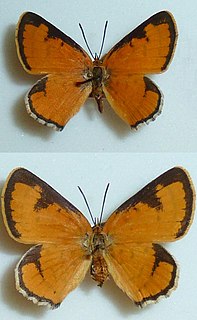
Erikssonia edgei, commonly known as the Waterberg copper, tilodi copper or Edge's acraea copper, is an obligate myrmecophylous lycaenid butterfly, which is native to Limpopo, South Africa. The critically endangered butterfly occurs in high-altitude grasslands on sandy substrates, and has only been obtained from the type and one subsequent locality. The population at the type locality, a farm in the Waterberg, went extinct about 12 years after its 1980 discovery. It was afforded species status in 2010, when no extant populations were known. The status of two populations, discovered in 2013 at a private nature reserve to the southeast, remains indeterminate.

Gentiana cruciata, the star gentian or cross gentian, is a herbaceous perennial flowering plant in the Gentianaceae family.
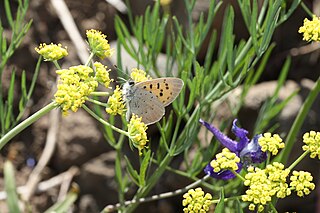
Lycaena rubidus, the ruddy copper, is a butterfly of the family Lycaenidae. It is found in the western mountains of North America. Adults lay their eggs on plants of the genus Rumex, which later become the larval food plants. This butterfly gets its name from the brightly colored wings of the males, which are important in sexual selection. Its larvae exhibit mutualism with red ants, and are often raised in ant nests until they reach adulthood. Adults are on wing from mid-July to early August.
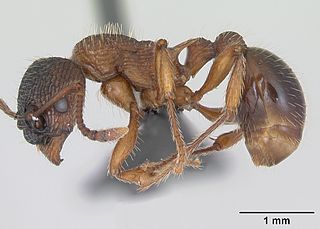
Myrmica schencki is a species of ant in the genus Myrmica.
References
- 1 2 Ichneumon eumerus Biolib
- ↑ Klim, Brandon (1 April 2008). "Butterfly and Wasp: A Devious, Deceitful Cycle of Life". Wired. Retrieved 14 December 2017.
- ↑ Harder, Ben (30 May 2002). "Ants Pawns In Battle Of Wasps, Butterflies". National Geographic News. Archived from the original on 10 June 2002. Retrieved 14 December 2017.
- ↑ Rowlings, Matt. "Maculinea rebeli" . Retrieved 14 December 2017.
- ↑ Quicke, Donald L.J. (2014). The Braconid and Ichneumonid Parasitoid Wasps: Biology, Systematics, Evolution and Ecology. John Wiley & Sons. pp. 395–396. ISBN 978-1-118-90705-4.